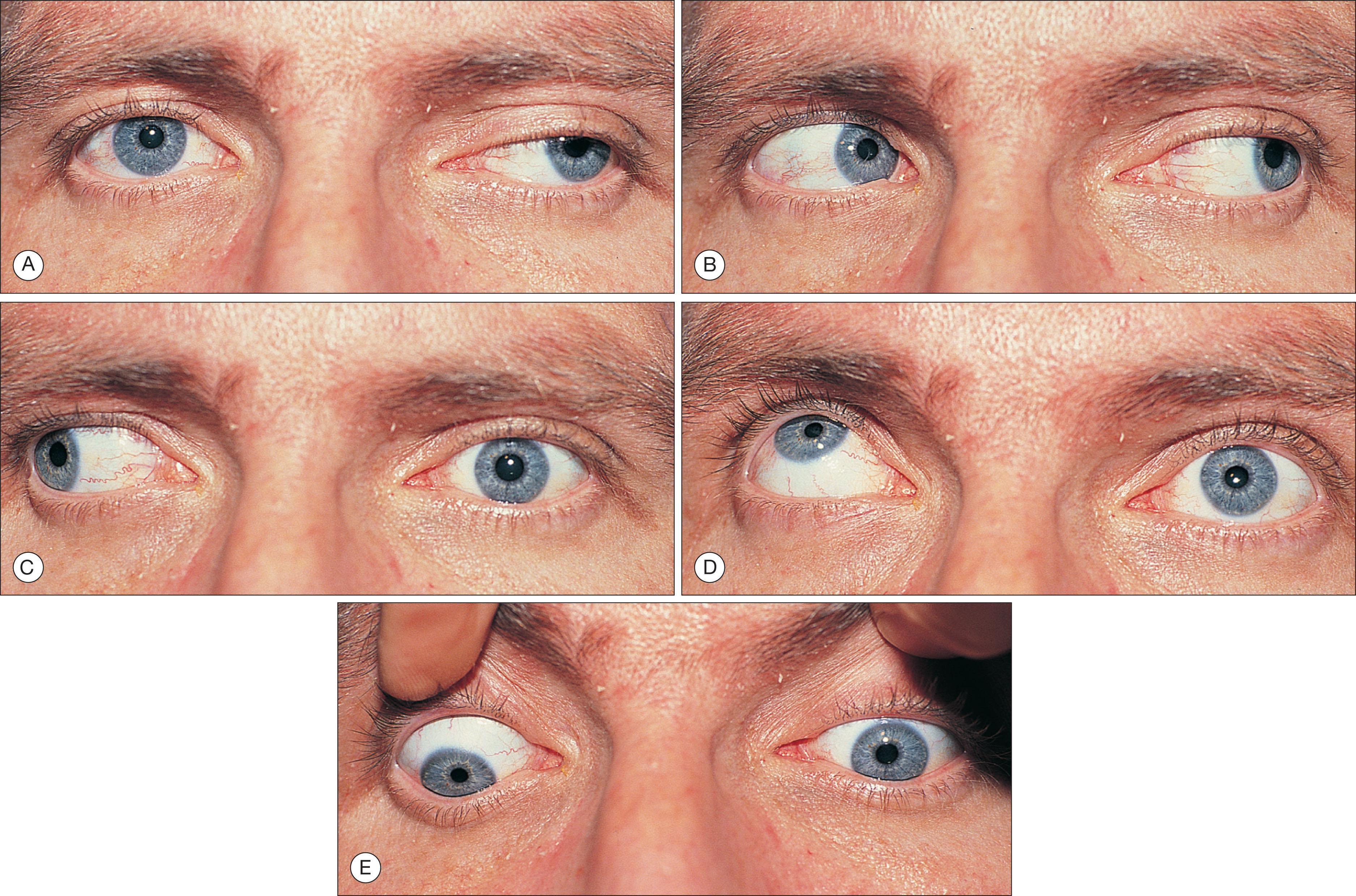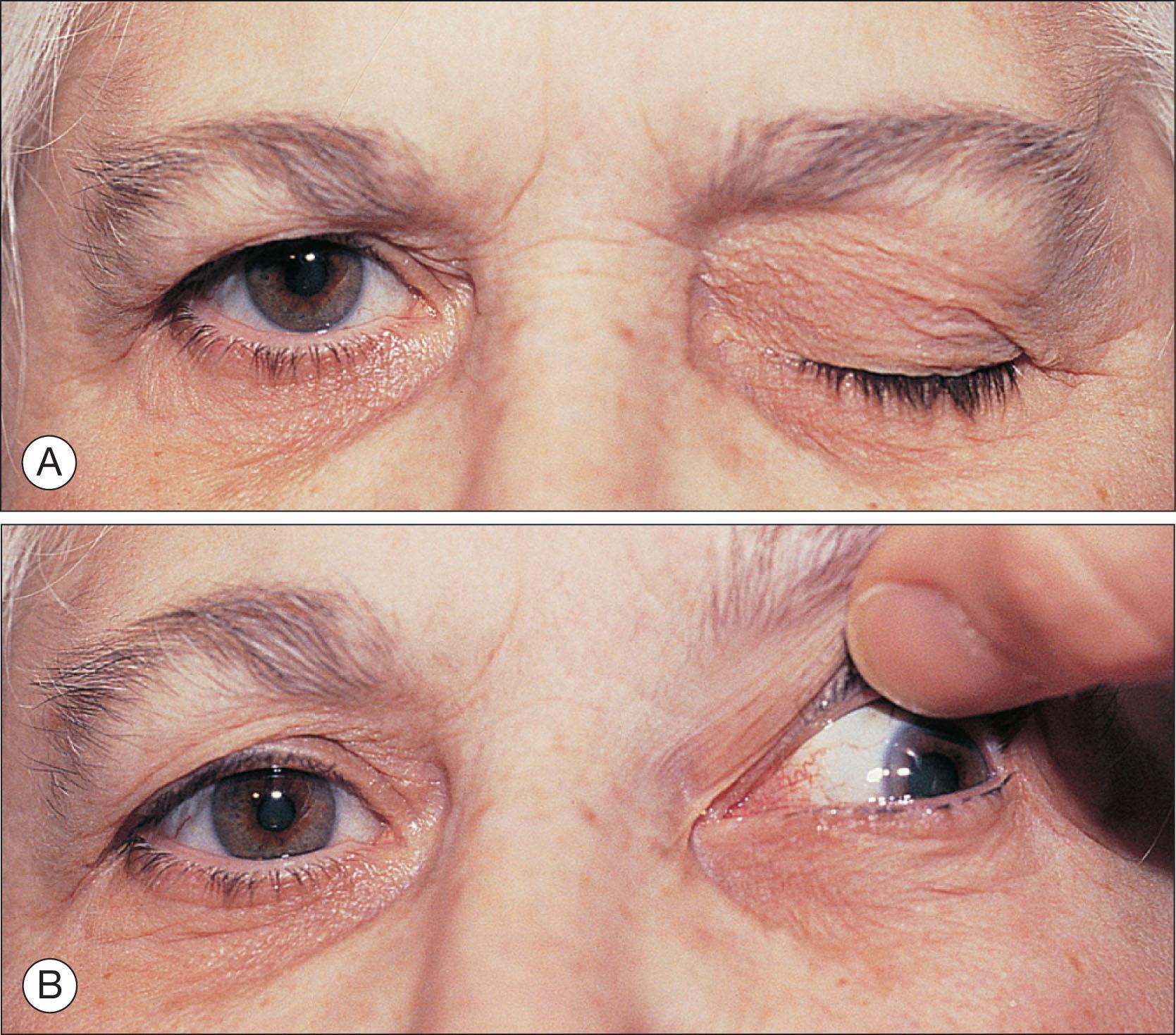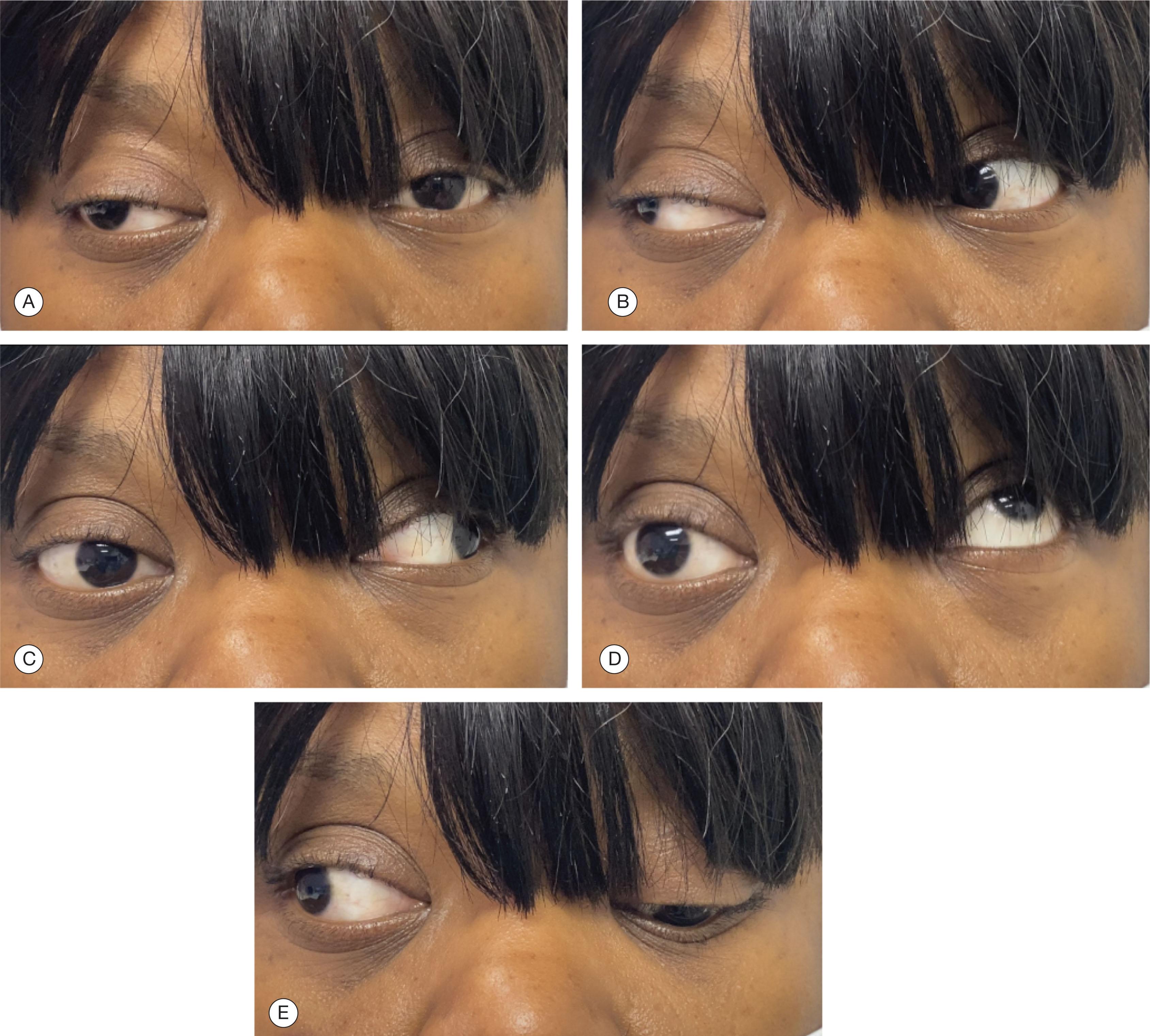Physical Address
304 North Cardinal St.
Dorchester Center, MA 02124
![]()
Strabismus resulting from partial or complete paralysis of the third, fourth, or sixth cranial nerve.
Incomitance—magnitude of deviation is gaze dependent.
Secondary deviation—magnitude of deviation increases when paretic or restricted eye is fixating on a target.
Third nerve palsy—ipsilateral exotropia, hypotropia, ptosis, and pupillary findings.
Fourth nerve palsy—ipsilateral hypertropia with head tilt to the opposite side.
Sixth nerve palsy—ipsilateral esotropia with head turn to the affected side.
The most common type of strabismus is the comitant variety—in which the angle of deviation does not vary with the direction of gaze. Less commonly, oblique or vertical rectus muscle dysfunction and orbital or rectus muscle pulley abnormalities may cause alphabet-pattern strabismus, as discussed in Chapter 11.8. Least common are the disorders that result from paresis or restriction of the extraocular muscles. This chapter discusses only paralytic strabismus.
In contrast to the straightforward evaluation of comitant strabismus, an expanded array of diagnostic techniques must be employed in patients with paralytic strabismus. Accurate classification of strabismus requires measurements in the cardinal positions of gaze (as discussed in Chapter 11.3) to detect the characteristic incomitance of paretic or restrictive disorders. In general, the measured deviation is greatest in the field of action of the paretic muscle(s).
With comitant strabismus, prism measurements are independent of the fixing eye, even in patients with a fixation preference for one eye. If the measurements change when the fellow eye takes up fixation, a paretic or restrictive etiology is usually the cause. The deviation is larger when the affected eye is used for fixation, termed secondary deviation .
Restriction can be confirmed by forced-duction testing, whereby the anesthetized perilimbal conjunctiva of the affected eye of a cooperative patient is grasped with a forceps and the eye is moved into the affected field; resistance indicates mechanical restriction (pointing to contracture of the antagonist muscle) rather than or in addition to muscle weakness as the cause of the strabismus. To confirm a paretic process, force-generation testing to assess the relative strength of a muscle is useful. The anesthetized perilimbal conjunctiva is grasped with a forceps, and the patient is instructed to look in the affected field as the examiner feels the pull of the affected muscle. Similar information can be gained from careful observation of saccades into the limited field. A steady but slow movement into the affected direction of gaze suggests a paretic cause, in contrast to an initially rapid and abruptly ending movement (like a dog running to the end of its leash), which suggests a restrictive cause.
Diplopia in adults and cooperative children can be assessed with binocular visual fields. This technique utilizes a standard Goldmann perimeter or tangent screen to identify and quantify the extent of the diplopic areas of gaze.
Comitant strabismus is rarely caused by other disorders; however, paralytic strabismus may be secondary to neurological or systemic diseases. Patients with extraocular muscle palsies require consideration for more extensive evaluation, usually based on age at presentation, specific cranial nerve affected, associated risk factors, and examination findings. A review of a case series of 10 cases of acquired cranial nerve palsies reported that almost all ophthalmologists and neurologists agreed that patients under 50 years of age and those with a third nerve palsy should undergo magnetic resonance imaging. In patients with fourth nerve palsy, neuroimaging was not indicated.
Management of paralytic strabismus follows the same general guidelines as for many difficult conditions—less invasive and less risky remedies are tried first. Hence, patients with a mild or slowly improving paresis can be offered occlusion or prism therapy before surgery is considered. Surgical treatment should be deferred until more than 6 months have passed after onset and serial examinations are stable. Before proceeding with surgery, the precise goals of treatment must be made exceedingly clear to the patient. The primary goals are to attain good ocular alignment in the primary position and downgaze, improve the incomitance, expand the field of single binocular vision, and improve compensatory head postures. Achieving good alignment in all fields frequently is not feasible. When surgery is planned, the muscle(s) at work in the field(s) of greatest deviation must be targeted. Although advocated by some for routine use in all cooperative strabismus surgical patients, adjustable sutures have an even greater potential role in surgery for paralytic strabismus. The great variability in the degree of weakness of affected muscles makes published tables of graded recessions and resections somewhat less reliable in nerve palsies. Appropriate informed consent for surgery requires discussion of the alternative treatments, including the option of no treatment. Details of surgical strategies are discussed with the individual nerve palsies.
Because the third nerve innervates the inferior oblique, inferior rectus, and medial rectus muscles (by its inferior division) and the superior rectus and levator muscles (by its superior division), palsy of this nerve can affect ocular motility in all three planes (horizontal, vertical, and torsional).
Third nerve palsies typically manifest ipsilateral exotropia and hypotropia with ptosis and pupillary findings. They can be congenital or acquired and can be partial, affecting one or more muscles ( Fig. 11.9.1 ), or complete ( Fig. 11.9.2 ). Cyclic palsies also have been reported.


Aberrant regeneration is a phenomenon peculiar to third nerve palsies, hence the alternative term oculomotor synkinesis . After a paretic event, the extramedullary axons can heal and regenerate, but not necessarily in their original locations. Therefore action potentials that previously resulted only in adduction may now produce depression, retraction (from simultaneous vertical rectus muscle contraction), globe elevation, lid elevation, or pupillary constriction. The two most common manifestations are lid elevation (pseudo-Graefe sign) and pupillary constriction, each of which occurs on adduction, downgaze, or both ( ![]() ). Aberrant regeneration is common in congenital third nerve palsy ( Fig. 11.9.3 ), reported in up to 83% of patients. However, primary aberrant regeneration without a history of a third nerve palsy should alert the clinician to possible nerve damage from a slowly enlarging compressive lesion, most commonly a schwannoma, meningioma, or carotid aneurysm within the cavernous sinus.
). Aberrant regeneration is common in congenital third nerve palsy ( Fig. 11.9.3 ), reported in up to 83% of patients. However, primary aberrant regeneration without a history of a third nerve palsy should alert the clinician to possible nerve damage from a slowly enlarging compressive lesion, most commonly a schwannoma, meningioma, or carotid aneurysm within the cavernous sinus.

Most studies have found that the most common cause of isolated pediatric third nerve palsies is congenital. Children with congenital third nerve palsies usually have unilateral involvement and no other neurological abnormalities; however, some of the latter have been reported. Congenital cases are generally considered nontraumatic in origin because excessive birth trauma is not consistently found.
Most often, in congenital palsies, all the extraocular muscles innervated by the third nerve are affected, resulting in exotropia, hypotropia, and ptosis of varying amounts. Pupillary involvement can result from either a primary manifestation of the palsy (a larger pupil from deficient sphincter innervation) or aberrant regeneration (pupillary constriction with adduction or downgaze). Pupillary sparing is not a reliable indicator of congenital origin because its presence in congenital cases is inconsistent. Most children suffer a loss of binocular function and amblyopia from ptosis or constant exotropia. When ptosis is either absent or incomplete, to optimize their binocularity, affected children may develop an abnormal head posture (torticollis) consisting of chin elevation and/or a contralateral face turn to neutralize the hypotropia, ptosis, or exotropia. Another amblyogenic factor is reduced accommodation in the affected eye, in which case a bifocal lens for near vision may be beneficial.
Congenital third nerve palsy should be distinguished from congenital fibrosis of the extraocular muscles (CFEOM). Absence or hypoplasia of the third cranial nerve has been described in CFEOM, which is a congenital cranial dysinnervation disorder. Presentation may be bilateral or unilateral, with variable degrees of ptosis, vertical movement deficits, reduction of horizontal eye movements, and pupillary findings. Three forms of CFEOM have been described based on phenotype—CFEOM1, CFEOM2, and CFEOM3—but the phenotypes can overlap, so identification of the underlying genetic mutations may allow more accurate diagnosis and classification.
Acquired third nerve palsies, although more common than their congenital counterpart, still are unusual. They produce an incomitant exotropia and/or hypotropia and/or ptosis. In addition, visually mature individuals report diplopia and visual confusion unless they also have significant ptosis. Torticollis (contralateral face turn and/or chin-up posture) develops if the posture neutralizes the diplopia.
The most common causes of acquired third nerve palsies in children include trauma, infection, migraine, and neoplasia. Children with a slowly progressive acquired isolated oculomotor nerve palsy and normal neuroimaging may not require more invasive investigation but should undergo repeat imaging every 2 years with the expectation of eventually detecting a small tumor, frequently a schwannoma.
The incidence of acquired third nerve palsies increases with age, and the causes are age dependent. Patients older than 60 years have the highest incidence (12.5 per 100,000), compared with 1.7 per 100,000 per year in patients younger than 60 years, predominantly because of a large increase in microvascular third nerve palsies.
Patients with an acquired third nerve palsy require further neurological evaluation because the palsy may be an ominous sign, although exceptions occur. Intracranial aneurysms are a dreaded cause of pupil-involving third nerve palsy because of the risk of a potentially fatal subarachnoid hemorrhage. However, once thought indicative of benign and non–life-threatening microvascular disease, pupillary sparing can occur even in cases caused by intracranial aneurysms. Pain and pupil involvement are unreliable in differentiating a microvascular from aneurysmal compression (see Part 9, Neuro-Ophthalmology, for specific details and recommendations for evaluating these patients).
Isolated pareses of individual muscles innervated by either branch of the third nerve have been described and generally defy neuroanatomic localization. They almost never are indicative of serious pathology, and manifestations depend on the affected muscle. Brown’s syndrome must be considered in a patient with an apparent isolated inferior oblique muscle palsy; the three-step test (discussed later) and forced-duction testing can usually distinguish between these two conditions. In patients who have craniofacial disease, isolated pareses may be caused by abnormalities of the orbit, abnormal insertion of the muscles, and congenital absence of a rectus or oblique muscle.
Third nerve palsy is the most challenging of the paralytic strabismus syndromes because of the number of muscles and different motility planes involved. Definitive treatment almost never is immediately required because many cases exhibit some degree of improvement, either spontaneously or when the underlying cause is managed.
In visually immature children, careful attention must be paid to both monocular and binocular visual development during this period because amblyopia can develop rapidly and require aggressive patching. In visually mature individuals without a complete ptosis, diplopia may be alleviated with occlusion during the period of expectant observation. Even incomplete occlusion, accomplished by applying translucent tape to a spectacle lens, may be sufficient. When the horizontal or vertical deviation is small, prisms may be beneficial to keep binocular development on track in children and alleviate diplopia in adults. Prisms may be a permanent solution when the residual deviation is small. Although prisms work best in small comitant deviations, success in incomitant strabismus is possible if the magnitude of the prism is chosen to match the functionally important primary and downgaze positions.
Botulinum toxin therapy can be a useful adjunct treatment in the acute phase. Injecting the antagonist muscle(s), either by direct surgical visualization or transconjunctivally under audible electromyographic control, can prevent permanent contracture, which would otherwise interfere with recovery or complicate subsequent surgical treatment, or both.
Restoration of normal motility generally is not attainable except in the mildest cases, so realistic surgical goals should be made clear to the patient in the early stages of treatment. Surgical treatment should be undertaken when little, if any, expectation of additional recovery exists, usually at least 6–12 months after onset. When some medial rectus muscle function is present, a large recess–resect procedure may produce acceptable results for the horizontal deviation; this has been advocated in some patients with complete paralysis if combined with a traction suture. The resected medial rectus can be supraplaced or infraplaced to improve an associated vertical deviation.
Resections of completely nonfunctional muscles have a limited long-term effect because the nonfunctioning muscle stretches with time; therefore when no demonstrable medial rectus function exists, some other method to generate passive adducting force is necessary in addition to functional inactivation of the lateral rectus muscle. The latter requires supramaximal recession of the lateral rectus muscle to at least 16 mm from the original insertion, fixation of the lateral rectus muscle to the periosteum of the lateral orbital wall, or extirpation or large myectomy of the lateral rectus muscle. Passive adducting force can be accomplished by transposition of the superior oblique tendon to a position between the superior and the medial rectus insertion, either with or without its removal from the trochlea. Additional alternatives include nasal orbital fixation and nasal transposition of the lateral rectus muscle. Nasal orbital fixation of the eye globe may be accomplished with the use of various materials, including an orbital bone periosteal flap, a nonabsorbable suture anchored to the medial orbital wall periosteum, or a T-plate titanium anchoring system fixated to the medial orbital wall. Transposition of the lateral rectus muscle to the superior and inferior borders of the medial rectus muscle, in combination with adjustable sutures or augmented fixation sutures, may generate adducting force and eliminate the lateral rectus opposing force. Adequate splitting of the lateral rectus muscle is critical when performing nasal transposition in order to avoid optic nerve compromise.
An accompanying ptosis generally is addressed after ocular alignment has been optimized because raising the lid of a hypotropic eye unable to utilize Bell’s phenomenon to protect the cornea may produce exposure keratitis and worsen diplopia. However, ptosis repair may be necessary before strabismus surgery in visually immature children to prevent the development or worsening of amblyopia.
With isolated muscle palsies, the prognosis for an acceptable outcome is greater because only one muscle is affected. Such pareses generally are treated by weakening the antagonist muscle along with strengthening (resection or plication) of the affected muscle, provided some of its function remains. In the case of isolated inferior oblique muscle paresis, weakening of the antagonist superior oblique muscle must be done with caution because of the resulting effects on ocular torsion. In such cases, contralateral superior rectus muscle weakening can be effective.
Whenever performing surgery on multiple rectus muscles of the same eye, anterior segment ischemia (ASI) is a possible complication. This condition may result when perfusion of the anterior segment is abruptly compromised by a sudden loss of the contribution made from the anterior ciliary arteries that normally accompany the rectus muscles and penetrate the sclera at the muscle insertions. The vertical rectus muscles generally contribute more than the horizontal rectus muscles. With time, perfusion to the anterior segment is restored by augmented circulation from the posterior ciliary circulation. This lends support to the strategy of staging surgery and waiting several months to operate on additional muscles of the same eye. ASI can occur years after the initial extraocular surgery or even after surgery on only two muscles. Acute manifestations of ASI include pain, corneal edema, Descemet’s membrane folds, and anterior chamber inflammation. Late effects include iris atrophy, an eccentric pupil, and infrequently, visual loss. Although ASI usually arises only with surgery on three or four rectus muscles, circumstances such as circulatory disorders or advanced age can increase the risk with surgery on fewer muscles. Preservation of the anterior ciliary circulation during rectus muscle surgery, either with or without the use of the operating microscope, has been proposed to reduce, if not eliminate, the risk of this complication (as discussed in Chapter 11.13).
Become a Clinical Tree membership for Full access and enjoy Unlimited articles
If you are a member. Log in here